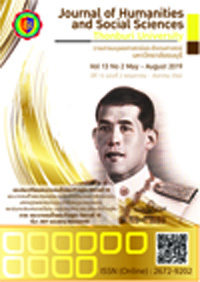การพัฒนาเกณฑ์การประเมินทักษะชีวิตสำหรับนักเรียนระดับมัธยมศึกษาตอนปลายในภาคตะวันออก: การวิเคราะห์โมเดลพหุระดับแบบผสานวิธี
คำสำคัญ:
เกณฑ์การประเมินทักษะชีวิต, นักเรียนระดับมัธยมศึกษาตอนปลายในภาคตะวันออก, การวิเคราะห์โมเดลพหุระดับแบบผสานวิธีบทคัดย่อ
การวิจัยมีวัตถุประสงค์เพื่อพัฒนาเกณฑ์การประเมินทักษะชีวิตสำหรับนักเรียนระดับมัธยมศึกษาตอนปลายในระดับนักเรียนและระดับโรงเรียน โดยใช้วิธีการวิจัยพหุระดับแบบผสานวิธี เก็บรวบรวมข้อมูลเชิงปริมาณด้วยการตอบแบบสอบถามมีลักษณะเป็นมาตรประมาณค่า 5 ระดับ กลุ่มตัวอย่างเป็นนักเรียนระดับมัธยมศึกษาตอนปลาย ปีการศึกษา 2560 จำนวน 500 คน จาก 50 โรงเรียนได้มาจากวิธีสุ่มแบบหลายขั้นตอน และวิเคราะห์องค์ประกอบเชิงยืนยันพหุระดับ โดยใช้โปรแกรม Mplus และเก็บรวบรวมข้อมูลเชิงคุณภาพด้วยการสัมภาษณ์เชิงลึกจากผู้ทรงคุณวุฒิจำนวน 13 คน เพื่อสรุปเป็นเกณฑ์การประเมินทักษะชีวิตสำหรับนักเรียนระดับมัธยมศึกษาตอนปลาย ผลการวิจัย ปรากฏว่า เกณฑ์การประเมินทักษะชีวิตสำหรับนักเรียนระดับมัธยมศึกษาตอนปลายในระดับนักเรียนและระดับโรงเรียนมี 2 องค์ประกอบหลัก ได้แก่ 1) ทักษะทางปัญญาอย่างมีวิจารณญาณมี 5 องค์ประกอบย่อย ได้แก่ ทักษะการตัดสินใจ ทักษะการแก้ไขปัญหา ทักษะการคิดสร้างสรรค์ ทักษะการคิดอย่างมีวิจารณญาณ และทักษะการสื่อสารอย่างมีประสิทธิภาพ และ 2) ทักษะทางสังคมและอารมณ์ มี 5 องค์ประกอบย่อย ได้แก่ ทักษะการสร้างสัมพันธภาพ ทักษะการตระหนักรู้ในตนเอง ทักษะการเห็นอกเห็นใจผู้อื่น ทักษะการจัดการกับอารมณ์ และทักษะการจัดการกับความเครียด สรุปได้ว่าเกณฑ์การประเมินทักษะชีวิตสำหรับนักเรียนระดับมัธยมศึกษาตอนปลายในระดับนักเรียน และระดับโรงเรียน ประกอบด้วย 2 องค์ประกอบหลัก 10 องค์ประกอบย่อย 40 ตัวบ่งชี้ และ 49 เกณฑ์การประเมิน สามารถจำแนกระดับการประเมินทักษะชีวิตสำหรับนักเรียนระดับมัธยมศึกษาตอนปลายออกเป็น 5 ระดับ ตั้งแต่ระดับที่ 1 (ต้องปรับปรุง) ถึงระดับที่ 5 (ดีเด่น)
เอกสารอ้างอิง
พนม เกตุมาน. (2550). พัฒนาการวัยรุ่น. สืบค้นเมื่อ 23 สิงหาคม 2561, จาก http://www.psyclin.co.th/new_page_56.htm
ภัทราวดี มากมี. (2562). การพัฒนาเกณฑ์การประเมินทักษะชีวิตสำหรับนักเรียนระดับมัธยมศึกษาตอนปลายในภาคตะวันออก: การวิเคราะห์โมเดลพหุระดับแบบผสานวิธี. วารสารวิชาการมหาวิทยาลัยธนบุรี.13(31).
วรรณวิมล สุรินทร์ศักดิ์ และประภัสสร ทองอุทัยศรี. (2553). พฤติกรรมการมีเพศสัมพันธ์ครั้งแรกของนักเรียนหญิงชั้นมัธยมศึกษาปีที่ 5 และอาชีวศึกษาประกาศนียบัตรวิชาชีพปีที่ 2 ประเทศไทย พ.ศ. 2548-2552. วารสารกรมการแพทย์. 35(5): 278-286.
วิภาวี ศิริลักษณ์, ปกรณ์ ประจันบาน;และ เทียมจันทร์ พานิชย์ผลินไชย. (2557). การพัฒนาตัวบงชี้ทักษะของนักเรียนในศตวรรษที่ 21. วารสารศึกษาศาสตร มหาวิทยาลัยนเรศวร. 16(4): 115-165.
วิระญา กิจรัตน์, ภัทราวดี มากมี และ ปิยะทิพย์ ประดุจพรม. (2561). การพัฒนาเกณฑ์การประเมินทักษะชีวิตสำหรับนักศึกษาอาชีวศึกษา: การวิเคราะห์พหุระดับแบบผสานวิธี. วารสารเทคโนโลยีภาคใต้. 11(1): 41-50.
สกาวเนตร ไทรแจ่มจันทร์, จารุวรรณ สกุลคู, อรรณพ โพธิสุข และจตุพล ยงศร. (2558). การพัฒนาหลักสูตรฝึกอบรมเพื่อเสริมสร้างทักษะชีวิตสำหรับนักเรียนพยาบาลทหารอากาศ. วารสารพยาบาลทหารบก. 16(2): 21-29.
สมพร คงวิมล, สมชาย เทพแสง และสรภัคสรณ์ ฉัตรกมลทัศน์ (2558). กลยุทธ์การพัฒนาทักษะชีวิตของนักเรียน. วารสารบริหารการศึกษา มศว. 12(22): 13-22.
Edmonds, W. A. & Kennedy, T. D. (2017). An applied reference guide to research designs: quantitative, qualitative, and mixed methods. 2nded. Thousand Oaks: SAGE.
Erawan, P. (2010). Developing Life Skills Scale for High School Students through Mixed Methods Research. European Journal of Scientific Research. 47(2): 169-186.
Hair, J. F., Black, W. C., Babin, B. J., & Anderson, R. E. (2010). Multivariate data analysis: A global perspective. 7thed. New Jersey: Pearson Education Inc.
Hooper, D., Coughlan, J., & Mullen, M. (2008). Structural Equation Modeling: Guidelines for Determining Model Fit. Electronic Journal of Business Research Methods. 6(1): 53-60.
Hox, J. J. (2010). Multilevel analysis: techniques and applications. 2nded. New York: Routledge.
Snijders, T. A. B., and Bosker, R. J. (2012). Multilevel Analysis: An Introduction to Basic and Advanced Multilevel Modeling. 2nded. London: Sage Publishers.
World Health Organization. (1997). Life skills education for children and adolescences in school. Geneva: Programme on Mental Health.
Translated Thai References
Chiv, C., & Makmee, P. (2518). Development of a Personality Scale for Upper Secondary Students in an Eastern Economic Corridor School. Journal of Thonburi University. 12(special): 71-81. (in Thai)
Ketman, P. (2007). Adolescent Development. Retrieved 23 August 2018, from http://www.psyclin.co.th/new_ page_56.htm (in Thai)
Kitjarat, W., Makmee, P., & Pradujprom, P. (2018). Development of Life Skills Assessment Criteria for Vocational Students: A Multilevel Model Analysis Using Mixed Methods. Journal of Southern Technology. 11(1): 41-50. (in Thai)
Kongvimon, S., Thepsaeng, S., & Chatkamonthat, S. (2015). Strategies of Developing for Student’s Life Skills. SWU Education Administration Journal. 12(22), 13-22. (in Thai)
Makmee, P. (2562). Development of Life Skills Assessment Criteria for Upper Secondary School Students in the Eastern Region: A Multilevel Model Using Mixed Methods. Journal of Thonburi University. 13(1). (in Thai)
Saichamchan, S., Skulkhu, J., & Potisuk, A., & Yongsorn, C. (2015). A development of training program to enhance life skills for the royal Thai air force nursing students. Journal of The Royal Thai Army Nurse. 16(2), 21 - 29. (in Thai)
Siriluk, W., Prachanban, P., & Panichparinchai, T. (2014). Indicators Development of Students Skills in the 21st Century. Journal of Education Naresuan University. 16(4), 115-165. (in Thai)
Surinsak, W., & Tonguthaisri, P. (2010). First sexual intercourse among female students of fifth-year of secondary schools and second-year of vocational schools, Thailand, 2005-2009. Journal of the Department of Medical Service. 35(5): 278-286. (in Thai)







